
views
Selecting the Cup Best for You

Identify the variables. Many brands of menstrual cups are on the market and they offer several options for you to choose from. Read the information provided by different manufacturers so you have a good understanding of the materials used in manufacturing and the features offered by their brand. Variables include the size of the cup, color choices, disposable vs reusable, amount of fluid they will hold, stiffness of the rim, stiffness of the lower part that holds the fluid, overall length of the cup, width measured at the rim, and the materials used in manufacturing.

Start with the size. There is no standard way to determine the correct size like you might do in choosing your shoes or your clothing. A “small” cup provided by one manufacturer may not be exactly the same as a “small’ cup provided by another. However, most manufacturers consistently recommend the choice of cup size, either small or large, based on general characteristics and categories of women. Cups generally come in either a small or large. General guidelines provided are a starting place, then you may need to tweak your choice of brand and size to find the cup that completely meets your needs. If you are a teenager, have never had sexual intercourse, are under the age of 30, have never delivered a baby vaginally, or exercise often, then you may want to start with a small. The smaller size has more to do with how it fits inside your vagina, and less to do with how much fluid it will contain. A large size is suggested for women that are over age 30, have had a vaginal delivery, or have a heavy menstrual flow.
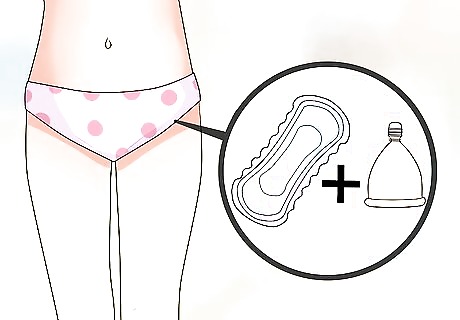
Take some time to adjust. Once you have chosen a brand and a size, take some time to get used to your menstrual cup. Wear a pad or pantyliner while adjusting to the cup to prevent leakage or spilling. It may take two to three menstrual cycles to decide if your first choice is the perfect fit. The companies that make menstrual cups understand it takes some adjustment. Many companies offer money-back guarantees for new users.

Know the capacity of your menstrual cup. The amount of fluid a menstrual cup can hold varies from one brand to another. All menstrual cups are advertised to hold more menstrual flow than that of a normal tampon. The average time recommended for use between emptying is 10 to 12 hours. If you have an exceptionally heavy flow, schedule your wear time for six to eight hours to prevent leakage. Take steps to have backup supplies available until you are comfortable with the length of time you can wear your menstrual cup without leakage.

Consider the other variables. Your menstrual cup should be comfortable. A reusable cup is made to last for years. When you have found the right cup you should not feel it all. If it feels uncomfortable, then try a different size or a different brand. Choose a cup that has a smaller rim width, or is more flexible in the part of the cup that collects the fluid.

Try a disposable cup. This may be a more comfortable option for you. Two types of disposable cups are made. One is intended to be thrown away after every use, and one is to be discarded at the end of that menstrual cycle. Disposable cups are made of very flexible material. The part that collects the fluid is very light-weight and flimsy.

Consider the length. If you have chosen a reusable product and you find it to be uncomfortable, pay attention to the length of the cup. Length is often the biggest problem that causes discomfort with a reusable menstrual cup. If you are uncertain, then start with a product that has a medium length. Most cups have a part that protrudes at the bottom, like a stem, that can be trimmed to help adjust the length to improve the fit. If you have a heavy flow or are having trouble finding a cup that fits you properly, consider comparing cups made by the same company as well as comparisons between some of the major companies. Additional information is available online that may help you in comparing the details of cups made by different manufacturers.
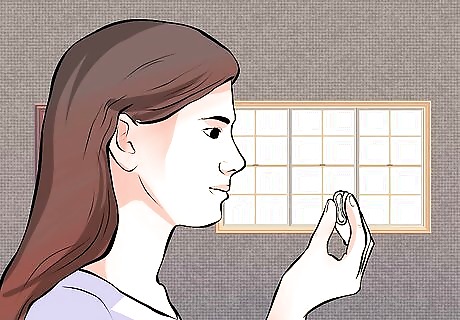
Select a cup with the right amount of firmness. For lack of exact medical terms, cups can be either softer or firmer. Cups that have a more solid or firmer structure in the bell shaped part that collects the fluid can be more comfortable for some women. Plus, firmer cups tend to leak less often since their structure is more rigid. The firmness helps the cup to open easier once inserted, maintain its shape against the vaginal wall, and avoid problems with sagging or sinking in of the sides. Firmer cups are often easier to remove since the walls of the cup fold in with pressure at the base, making it easier to break the suction. However, because of the stiffer or firmer structure, you may feel the cup once it is inserted, causing some pressure and possibly some discomfort. Softer or more pliable cups put less pressure on the bladder, are generally more comfortable to wear, and conform to women that may have a unique shape to their uterus. The softer cups may be more difficult to remove since the entire cup does not respond to the pressure from your finger when you are trying to break the suction to remove it. In general, softer cups may leak more since they can cave in or give way to changes in movement caused by the muscles of your vaginal wall.

Select a color. Some companies offer their menstrual cups in a rainbow of colors. The disposable cups are clear. If you prefer a clear cup, most brands of reusable cups are also available as a clear option. The colors are helpful in hiding any stains that result from repeated use. The clear cups can also be thoroughly cleaned and soaked in hydrogen peroxide to remove any stains from repeated use.
Reviewing the Advantages

Know that you can wear your cup during physical activity. The menstrual cup is a good option for women that exercise regularly. Some disposable cups can be worn during sexual intercourse.. The disposable menstrual cup is not a form of birth control and does not protect against sexually transmitted diseases. The reusable cups are made of a more solid material and are not to be inserted or in place during sexual intercourse. Menstrual cups can be worn during physical exercise such as swimming, playing sports, or bicycling.

Have the freedom to extend your time between changes and eliminate odor. The use of typical period products require changing every few hours. But menstrual cups can be in place for as long as 12 hours. In addition, menstrual pads can cause an odor since your flow is exposed to air. The menstrual cup collects the flow inside your vagina and prevents any problems with an odor.

Be aware that menstrual cups reduce your risk of infection. Provided you keep your cup clean, this method of managing your menstrual flow has a lower risk of infection. There is no change in the pH of your vaginal area with the use of a menstrual cup and there are no problems with tiny tears in the surrounding vaginal tissue, as can happen with the use of tampons. Changes in the pH and “micro-tears” can lead to bacterial infection. This is avoided with the use of a menstrual cup.

Consider the safe regulation of menstrual cups. The menstrual cups advertised and sold in the United States have been approved by the FDA. The FDA has deemed menstrual cups to be safe for use. Most companies use hypoallergenic and nontoxic materials in the manufacturing process. Some menstrual cups can be used safely by women with latex allergies. Check the product literature to be sure.

Avoid Toxic Shock Syndrome by using a menstrual cup. Toxic Shock Syndrome has been linked to the vaginal use of tampons during menstruation. Toxic shock syndrome is a bacterial infection linked to problems with the use of tampons. There have been no reports of toxic shock syndrome reported due to the use of menstrual cups.

Save money and the environment when you use a reusable menstrual cup. Reusable cups save money and are considered to be eco-friendly. The purchase of a menstrual cup is more costly than purchasing a package of tampons or pads, but your menstrual cup purchase will last for years. The disposable cups are less costly than the reusable cups and are comparable in price to other period products, depending on where you shop. The reusable cups prevent the accumulation of period products that end up in landfills.

Remember that menstrual cups can be easy to use. Once you are comfortable with insertion and removal, using a menstrual cup is an easy way to take care of your monthly period. Every manufacturer offers step-by-step instructions on both insertion and removal contained within their product literature, available online at their product websites, and many offer YouTube videos to help with understanding the procedures. The cup is folded, then gently slid into the vagina aimed toward the back, then given a little push to secure it in place. Remove the cup by pinching the base, then pulling it out. Do not pull directly on the stem, since the cup is secured by suction. By pulling on the stem, you can cause injury to the surrounding tissues.
Evaluating the Disadvantages
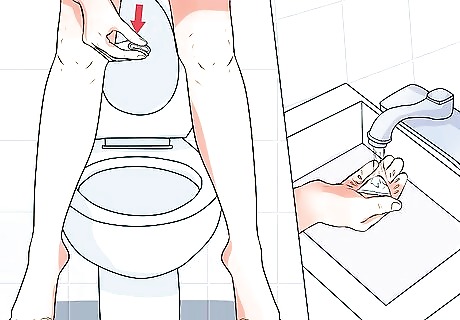
Consider the clean-up process. Menstrual cups can be messier. As you remove the cup, you are also removing the fluid that it has collected over the past eight to 12 hours. It takes some practice to develop a system that works for you. Many women remove it while “hovering” over the toilet to avoid any spills on their clothing or the floor. If possible, you may also want to practice removing the cup while in the shower. The cup can be cleaned with fresh water then reinserted for the next 8 to 12 hours. You may want to wear a pad or panty liner until you have mastered the removal and insertion of your menstrual cup. When you need to perform this removal and reinsertion in a public restroom, you may need to strategize to come up with the best way to rinse your cup, since sinks are not usually part of the individual stalls.
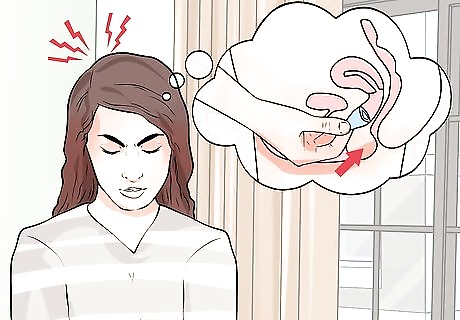
Know you may have trouble inserting the menstrual cup. Some women have trouble with insertion. Teenagers and younger women sometimes have trouble with inserting a menstrual cup. Some women that have never had sexual intercourse have trouble with insertion.
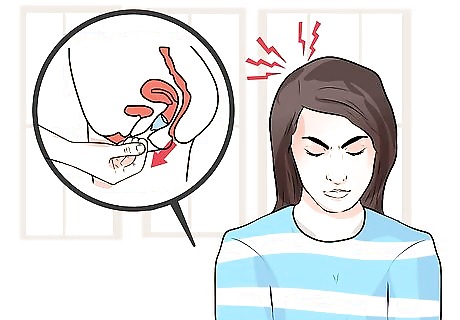
Be aware that you may struggle to remove the cup. Problems with removing the cup are more common than insertion difficulties. It is important not to pull down on the stem. Since the cup is being help in place by suction, pulling down on the stem can cause irritations or even tears to the surrounding vaginal tissue. The proper way to remove the menstrual cup is to pinch the base to break the suction, then pull down and out. Empty the collected fluid into the toilet, clean the cup with fresh water, and reinsert.
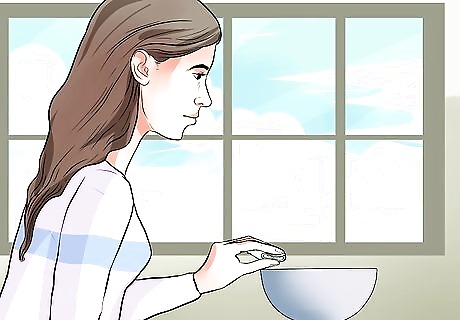
Decide if you have the time to sterilize the cup after each use. Once you have completed your menstrual cycle, you must clean the cup thoroughly. If you don't think you have time or would be willing to do this, then the menstrual cup may not be for you. You can sterilize the cup by placing it in a shallow pan of boiling water for five minutes. Other methods used for baby bottles and pacifiers using sterilizing solutions can also work for menstrual cups. Follow the guidelines for cleaning provided in the product literature.
Avoiding Possible Complications

Select a latex free product. If you are allergic to latex, some menstrual cups are made of materials that are safe. Read the product literature to be sure. Select a cup made of medical-grade silicone if you have a latex allergy.
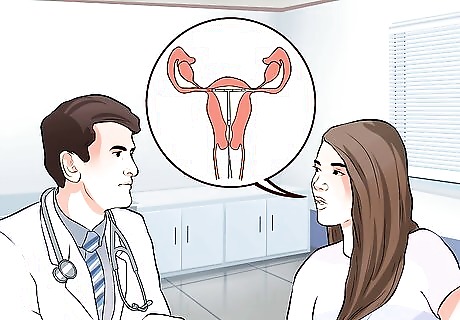
Talk to your doctor if you have an IUD. Most doctors recommend against using a menstrual cup if you have an IUD in place. There have been reports of IUD’s being dislodged during insertion or removal of a menstrual cup. Check with your doctor to be sure it is safe for you to try a menstrual cup before you purchase one.

Avoid using a menstrual cup if you have certain medical conditions. Check with your doctor to be sure it is safe for you if you have any concerns. Do not use a menstrual cup if you have recently delivered a baby or recently had a miscarriage or abortion. Do not use a menstrual cup if you have been told you have a tilted uterus. Avoid using a menstrual cup if you were told to avoid using tampons due to a surgical procedure or other medical condition. Do not use a menstrual cup if you have a condition called pelvic organ prolapse.

Know if you are at risk of endometriosis. Talk to your doctor about this prior to trying a menstrual cup. This is extremely unlikely, but you may wish to discuss it with your doctor. One case report of endometriosis was linked to the use of a menstrual cup. The FDA considers the use of menstrual cups to be safe, but discuss this with your doctor if you have any concerns.
















Comments
0 comment